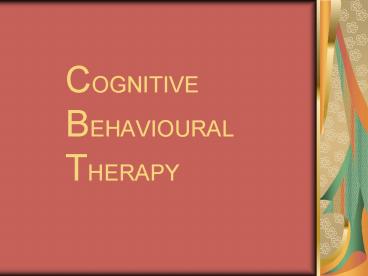COGNITIVE BEHAVIOURAL THERAPY - PowerPoint PPT Presentation
1 / 19
Title:
COGNITIVE BEHAVIOURAL THERAPY
Description:
COGNITIVE BEHAVIOURAL THERAPY Psychoeducation from RCT, educational materials play a significant role in improvement in depression Robinson, Katon, Von Korff et al ... – PowerPoint PPT presentation
Number of Views:199
Avg rating:3.0/5.0
Title: COGNITIVE BEHAVIOURAL THERAPY
1
COGNITIVE BEHAVIOURALTHERAPY
2
Psychoeducation
- from RCT, educational materials play a
significant role in improvement in depression - Robinson, Katon, Von Korff et al., 1997
3
Cognitive Behaviour Therapy
- Dispute about unique effect
- Murphy, Carney et al., 1995
- May reduce relapse
- Fava, Grandi, Zielezny et al., 1996
- Therapist competency is vital
- Scott, Tacchi, Jones Scott, 1997
- Meta-analysis suggests effect size post-treatment
- Reinecke, Ryan DuBois, 1998
4
CBT Assumptions
- Cognitive activity affects behaviour
- Cognitive contents processes can be monitored
changed - Behavioural ( emotional) change may be affected
through cognitive change - Dobson and Dozois, 2001
5
Other assumptions
- Processing of information is active adaptive
- Individuals derive meaning from their experiences
using information processing - Belief systems are idiosyncratic
- New information is assimilated into existing
belief systems
6
Automatic Thoughts (Beck)
- Specific, discrete essential words
- Shorthand distilled format
- Not a result of deliberation, reasoning, or
reflection - Just happen - Not sequential as in goal directed thinking or
problem solving - Autonomous person does not need to make any
effort to generate may have difficulty
switching off
7
Core Beliefs
- Learned through childhood experiences
- 2 broad categories helplessness and
unlovability - Core dysfunctional beliefs latent during low
stress periods - Reactivated by negative experiences that resemble
conditions under which original beliefs were
formed
8
Cognitive Distortions
- Overgeneralisation
- Dichotomous thinking
- Magnification
- Personalisation
- Disqualifying positives
- Jumping to conclusions
- Catastrophising
- Emotional Reasoning
- Shoulds Oughts
- Labels
9
Cognitive Triad
- Negative view of self, the world, and the future
central to maintenance of depression - Beck (1983) subsequently proposed that
individuals are particularly likely to experience
depression if there is a congruence between
negative life events depressogenic schemata
10
Research
- High levels of depressive symptomatology in
children with pessimistic attributional styles
and presence of internal, stable, global negative
style - suggest causal role of attributional style in
development of depression - increase risks of depression in adolescence
- predict future increases in depressive symptoms
among adolescents irrespective of negative life
events - Spence et al., 2002
11
Research
- 40 of adolescents who responded to CBT relapsed
within 6 months - Significant number of adolescents discontinue
treatment prematurely, do not comply or remain
depressed at end of intervention (approx 33) - Younger children seem to better
- Need to investigate involvement of family
- Spence Reinecke, 2004
12
Major CBT strategies
- Behavioural activation
- Getting the person to do something
- Monitoring activities, pleasure, mastery
- Scheduling activities
- Graded task assignment
- Cognitive activities
- Distraction techniques
- Time set aside for thinking
13
Major CBT strategies
- C-B strategies
- Identifying negative thoughts
- Questioning negative thoughts
- Behavioural experiments
- Preventative strategies
- Identifying assumptions
- Challenging assumptions
- Use of set-backs
- Preparing for future
14
Initial Interview
- Assessment of current difficulties
- Symptoms
- Life problems, e.g., interpersonal, medical,
practical - Associated negative thoughts
- Onset/development/context of depression
- Hopelessness/suicidal thoughts/lack of energy
- Agreed problem list
15
Initial Interview
- Goal definition may change later but helps
correct unrealistic expectations, provides a
standard to monitor progress, focuses attention
on future. - Presentation/acceptance of treatment rationale
- Practical details what is involved, homework,
between session tasks, frequency
16
Initial Interview
- Introduction to basic relationship between
negative thoughts depression - Possibility of change
- Beginning intervention
- Specific
- Select first target
- Agree appropriate homework, monitoring/reading
- General
- Give Client experience of CBT style (focus on
specific issues, active collaboration, homework) - Overall aims
- Establish rapport
- Elicit hope
- Give pt preliminary understanding of model
- Get working agreement to test it in practice
17
Subsequent sessions
- Set agenda
- Weekly items
- Review events from last session
- Feedback from client on last session
- Homework review (emphasises self-help,
independent functioning) - Outcome?
- Difficulties?
- What has been learned?
18
Subsequent sessions
- Major topic for session
- Specific strategies (e.g., relaxation, learning
evaluate automatic thoughts - Specific problems (e.g., difficulties that have
arisen during week) - Long term problems
- List in order of priority
19
Subsequent sessions
- Homework assignments
- Task
- Should follow logically from session content
- Needs to be clearly defined
- Rationale
- explicit e.g., to test the idea that I cant do
anything, a no lose situation will learn
something regardless - Predicted difficulties
- Feedback from client
- Understanding ( summarise main points
- Reactions to session































